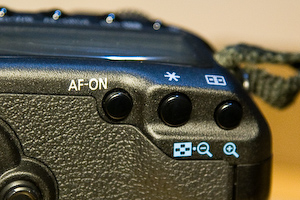We had some snow yesterday, which is rare here in the Willamette Valley. I went out early in the morning and tried to make a few images. Here I liked the contrast between the snow texture and the bright green blades of grass. Photographed on December 15, 2008.
Monthly Archives: December 2008
Adobe released Lightroom 2.2
Hooray! Lightroom 2.2 is released. Now my 5D Mark II workflow will be simplified. I’m downloading as we speak.
Winter Sky
I like the arrangement of these leafless trees against the winter morning sky. Photographed on December 15, 2008.
Blackberry Leaf
Fall may be over, but some of the blackberry brambles are still showing some color in their leaves. I forgot to bring my extension tubes, so I had to crop this one to get the composition that I wanted. Photographed on December 14, 2008.
Why you should use the AF-ON button

By default, most SLRs autofocus when you half-press the shutter button. If you want to recompose before taking the picture, you have to keep the button held down while you recompose. This can be awkward, which is why many photographers choose to do things differently by remapping autofocus to a separate, dedicated button. I first learned about this technique when I was shooting sports and have since taken it for granted. With the release of the 5D Mark II and it’s new AF-ON button, I thought some people might be wondering what it’s all about.
To get the benefits of the AF-ON button, you need to change Custom Function IV-1 to 2, which will disable the default autofocus behavior of the shutter button. Now the camera will only autofocus when you press the AF-ON button. Once you release the button, the focus will stay where you left it and you’re free to recompose at will. If the camera-to-subject distance isn’t changing, you might take many photos before refocusing again.
One of the things I really like about this setup is that I don’t need to worry about turning autofocus off when I’m composing a landscape image on a tripod. I usually focus such images manually so as to maximize depth of field. Since most of the lenses that I use feature full-time manual focusing, I don’t even need to move the switch on the lens out of the AF position.
Finally, if you want to track a moving subject, just set your AF mode to AI SERVO. Now you can hold down the AF-ON button to track your subject. In fact, I leave my camera set to AI SERVO all the time. For static subjects I just press the AF-ON briefly until I get a focus lock. Technically ONE SHOT is supposed to be more accurate for static subjects, but I haven’t had any problems. Besides, if I want critical focus on a static subject I’m more likely to check focus by eye or with live view.
If your camera doesn’t have a dedicated AF-ON button, most Canon SLRs allow you to set a custom function that moves AF activation to the * (exposure lock) button. Other manufacturers usually include similar functionality.
Update: One more thing. Maybe it goes without saying, but this technique works best if you’re using a single AF point.
Lightroom 2.2 release date
Adobe’s website is now listing December 16 as the expected release date for Lightroom 2.2. This version will include support for the Canon 5D Mark II and other new cameras. I’m looking forward to being able to import my 5D Mark II images directly into Lightroom, so I hope the date is accurate.
Update: Hmm, it’s already been removed from that page. Guess they jumped the gun by posting before the download was there. I should have taken a screenshot.
In the interim, I’ve had good results using version of 5.2 of Adobe’s free DNG converter to process my 5D2 RAW images. After conversion, I can import the DNG files into Lightroom 2.1.
Coastal Abstract
This is probably my favorite image from this series of abstracts. Photographed on December 6, 2008.
Canon is preparing to comment on the black dot problem
Here’s some new information from CNET’s Underexposed blog.
Canon’s Chuck Westfall writes a monthy column at The Digital Journalist. In response to a comment about the infamous 5D Mark II black dots, he wrote: “Watch for an official Canon comment on this issue in the very near future.”
It’ll be interesting to see what they have to say. Hopefully some sort of fix is forthcoming.
Red Sand
Here’s another little abstract from the beach. I liked the red reflections from the sunset. Photographed on December 6, 2008.
DxOMark analysis of 5D Mark II
DxOMark has posted their analysis of the 5D Mark II. If you look at the comparison to the 1Ds Mark III, the 5D2 is nearly identical at ISO 100, with very small numerical advantages in some areas going to the 1Ds3. As the ISO increases, the 5D2 pulls ahead a bit in nearly every test. Go see the results for yourself. Lab testing is only one part of the story when reviewing a camera, but I think these results clearly indicate that the 5D2 can go toe-to-toe with the 1Ds3 in terms of raw image quality…that is, once those pesky black spots go away.